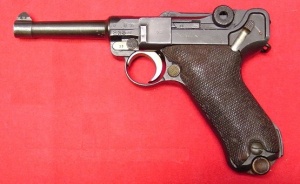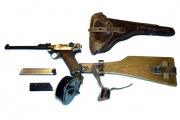Difference between revisions of "Luger P08 pistol"
m (1 revision) |
Latest revision as of 15:47, 15 March 2013
| Luger P08 (Parabellum) | |
|---|---|

| |
| P08 of the German Reichsmarine R.A.Smith collection | |
|
| |
| Type | Service pistol |
| Land of Origin | German Empire |
| Specifications | |
| Length | 8.75 in. |
| Barrel length | 98–203mm (3.9–8.02 in.) |
| Weight | 1.92 lbs. |
| Cartridge | 7.65x22mm Parabellum 9mm Parabellum |
| Action | Toggle-locked, short recoil |
|
| |
| Feed | 8-round detachable box magazine, 32-round detachable drum. |
| Sights | Iron sights |
| Service History | |
| In service | Germany 1904–1945 Switzerland 1900–1945 |
| Used by | Germany, Switzerland |
| Wars | World Wars I & II, Chinese Civil War |
| Production History | |
| Designer | Georg J. Luger |
| Design Date | late 1890s |
| Manufacturer | Deutsche Waffen und Munitionsfabriken |
| Produced | 1900–1942 |
The Luger was made popular by its use by Germany during World War I and World War II. Though the Luger pistol was first introduced in 7.65x22mm Parabellum, it is notable for being the pistol for which the 9x19mm Parabellum (also commonly known as the 9mm Luger) cartridge was developed.
Contents |
[edit] Design
The Luger uses a toggle-lock action, which utilizes a jointed arm to lock, as opposed to the slide actions of almost every other semi-automatic pistol. After a round is fired, the barrel and toggle assembly (both locked together at this point) travel rearward due to recoil. After moving roughly one-half inch (13 mm) rearward, the toggle strikes a cam built into the frame, causing the knee joint to hinge and the toggle and breech assembly to unlock. At this point the barrel stops its rearward movement (it impacts the frame), but the toggle and breech assembly continue moving (bending the knee joint) due to momentum, extracting the spent casing from the chamber and ejecting it. The toggle and breech assembly subsequently travel forward (under spring tension) and the next round from the magazine is loaded into the chamber. The entire sequence occurs in a fraction of a second. This mechanism worked well for higher pressure cartridges, but cartridges loaded to a lower pressure could cause the pistol to malfunction because they did not generate enough recoil to work the action fully. This resulted in either the breechblock not clearing the top cartridge of the magazine, or becoming jammed open on the cartridge's base.[2]
In World War I, as submachine guns were found to be effective in trench warfare, experiments with converting various types of pistols to machine pistols (Reihenfeuerpistolen, literally "row-fire pistols" or "consecutive fire pistols") were conducted. Among those the Luger pistol (German Army designation Pistole 08) was examined; however, unlike the Mauser C96, which was converted in great numbers to Reihenfeuerpistolen, the Luger proved to have an excessive rate of fire in full-automatic mode.
The Luger pistol was manufactured to exacting standards and has a long service life. William "Bill" Ruger praised the Luger's 55 degree grip angle and duplicated it in his .22 LR pistol.
[edit] Service
The P.08 was the usual sidearm for German Army personnel in both world wars, though it was being replaced by the Walther P38 starting in 1938. In 1930, Mauser took over manufacture of the P.08 (until 1943).[3] The Swiss Army evaluated the Luger pistol in 7.65 mm P (.30 Luger in USA) and adopted it in 1900 as its standard sidearm, designated Ordonnanzpistole 00 or OP00, in 1900.
The Luger pistol was accepted by the German Navy in 1904, and in 1908 (as Pistole 08) by the German Army (chambered in 9x19mm Parabellum) replacing the Reichsrevolver. The Lange Pistole 08 or Artillery Luger had a stock and longer barrel, and sometimes used with a 32 round drum magazine (Trommelmagazin 08).
The United States evaluated several semi-automatic pistols in the late 1800s, including the Colt M1900, Steyr Mannlicher M1894, and an entry from Mauser. In 1900 the US purchased 1000 7.65 mm Lugers for field trials. Later, a small number were sampled in the then-new, more powerful 9 mm round. Field experience with .38 caliber revolvers in the Philippines and ballistic tests would result in a requirement for still-larger rounds.In 1906, the US Army held trials for a large-caliber semi-automatic. DWM provided two samples chambered in .45 ACP for testing. One of these two pistols is exhibited at the Norton Gallery, in Shreveport, Louisiana. After initial trials, DWM, Savage, and Colt were asked to provide further samples for evaluation. DWM withdrew, for reasons that are still debated, even though the Army did place an order for 200 more samples.
[edit] Usage today
Although obsolete, the Luger is still sought after by collectors both for its sleek design, superlative accuracy, and by its connection to Imperial and Nazi Germany. Limited production of the P.08 by its original manufacturer resumed when Mauser refurbished a quantity of them in 1999 for the pistol's centenary. More recently, Krieghoff announced[4] the continuation of its Parabellum Model 08 line with 200 examples at $15,950.00 a piece. The Luger was prized by Allied soldiers during both of the World Wars. Thousands were taken home during both wars, and are still in circulation today.[5]
[edit] Resources
| Gun Owners' Resource has the following relevant documents available for free download for the Luger P08 pistol and/or its variants: |
- Guide on the Use of the German Model P.08 Pistol by Century International Arms (5 pages, 3.25MB .pdf file)
- Anleitung zur: Kenntnis und Behandlung der Pistole 1900/06 Vom schweiz Bundesrate genehmigt den 31 Januar 1911[6] [Deutsch] (14 pages, 2MB .pdf file)
The following images are also available for reference:
[edit] Bibliography
- Imperial Lugers by Jan C. Still (Still's Books - 1994)
- Third Reich Lugers by Jan C. Still (Still's Books - 1988)
- Weimar Lugers by Jan C. Still (Still's Books - 1993)
- Lugers at Random by Charles Kenyon (Hand Gun Press - 1990)
- La Luger Artiglieria by Mauro Baudino (Editoriale Olimpia - 2004)
[edit] References
- ↑ Fitzsimons, Bernard, ed. The Illustrated Encyclopedia of Weapons and Warfare (London: Phoebus, 1977), Volume 16, p.1778, "Luger".
- ↑ Hogg, Ian & Weeks, John. "Military Small Arms of the 20th Century". Krause Publications. (2000) ISBN 0-87341-824-7
- ↑ Fitzsimons, p.1778.
- ↑ http://www.krieghoff.com/content/view/176/145/
- ↑ Bishop, Chris (1998), The Encyclopedia of Weapons of World War II, New York: Orbis Publiishing Ltd, ISBN 0-7607-1022-8 .
- ↑ Translation: Instructions for: knowledge and treatment of the 1900/06 pistol, From the Swiss Federal Council, approved January 31, 1911




